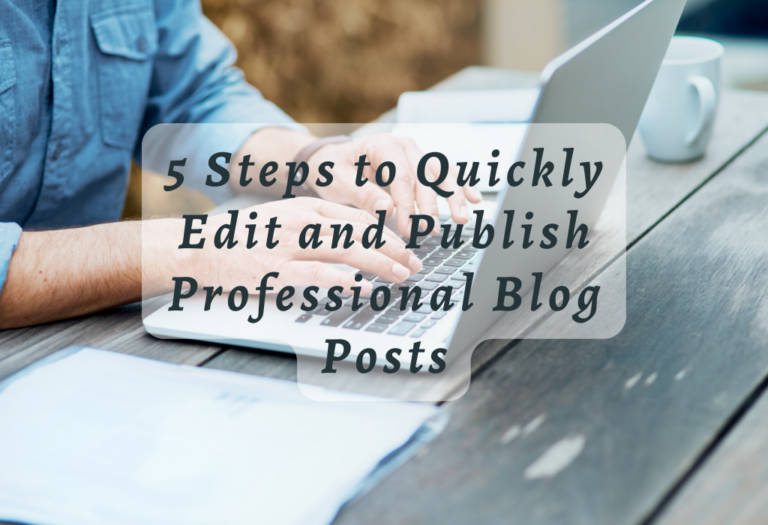7 Blog Post Templates to Help Marketers Succeed
As marketers, we all know how important it is to create content that resonates with our target audience. To do this effectively, a well-crafted blog post template can make the process easier and faster.
In this article, I’m going to show you seven of the most effective blog post templates for creating engaging content quickly – from list posts and step-by-step guides to expert roundups and case studies. All these strategies are proven methods for boosting your SEO efforts while providing valuable information to readers – so let’s dive in!

Listicle Template – The List Post
Listicle posts are a great way to provide readers with an overview of a topic in an easily digestible format. This type of post typically consists of a list, usually numbered or bulleted, that provides information on the topic at hand. The list can be used to compare different products, services, or ideas and provide readers with quick insight into the subject matter.
For example, if you were writing about digital marketing tools for small businesses you could create a listicle post that compares popular options such as Hootsuite and Sprout Social. You could include features like pricing plans, customer service ratings, ease-of-use scores, etc. so that readers can quickly get an idea of which tool is best suited for their needs without having to do extensive research themselves.
Tips while using Listicle Template
When creating your listicles it’s important to make sure each item on the list is relevant and informative. If possible try to include images or screenshots alongside each entry as this will help break up the text and make it easier for readers to scan through quickly. Additionally, don’t forget to link out where appropriate so that users can find more detailed information if they need it.
Benefits You get using Listicles
Overall, listicles are a great way to give your audience comprehensive yet concise information on any given topic in one easy-to-read format; making them perfect for busy professionals who want answers quickly. Creating a listicle post is an effective way to engage readers and provide them with useful information in an easy-to-read format.
Key Takeaway: Creating a Listicle Template helps you organize your blog post in much a simpler and more informative form. Now let’s take a look at how you can use the How-To Blog Post Template for your content.
To go through a listicle template, click here.
How-To Blog Post Template – The Step-By-Step Guide
The step-by-step guide is a great blog post template for providing readers with detailed instructions on how to do something related to the topic. It should include clear and concise steps, images, and/or videos that help readers understand the process better.
Step 1 – Research Your Topic
When writing a step-by-step guide, it’s important to research your topic thoroughly so you can provide accurate information. Take time to read up on the subject matter and find out what other experts have said about it. This will ensure that your content is reliable and trustworthy.
Step 2 – Outline Your Post
Once you’ve done your research, create an outline of your post so you know exactly what needs to be included in each section. Make sure each step is clearly defined and easy for readers to follow along with. This will make it easier for them to complete the task at hand without getting confused or overwhelmed by too much information all at once.
Step 3 – Write Your Post
Now that you have an outline of your post ready, start writing. Be sure to explain each step in detail while also keeping things simple enough for anyone who reads it to understand easily. Include any helpful visuals such as screenshots or diagrams if necessary as well as links back to sources where appropriate.
Step 4 – Proofread & Publish
Before publishing your post, take some time to proofread everything one last time. Check for typos or grammar mistakes that may have been overlooked during the editing process and make sure all links are working properly too before sending it out into cyberspace.
Key Takeaway: Creating a how-to blog post template is an effective way to provide valuable information to your readers and boost SEO. Now, let’s look at another useful blog post template – the comparison article.
Click here to access the step-by-step guide blog post template
Comparison Article Template
Comparing two or more items related to a topic can be an effective way for marketers to provide readers with the information they need to make an informed decision. The comparison article template is ideal for this purpose and should include an overview of each item being compared, as well as the pros and cons of each item.
Give Overviews
When writing a comparison article, it’s important to provide readers with clear overviews of each item being compared. This should include basic facts about the product or service, such as its features, benefits, pricing structure, and any other relevant details that will help readers understand what they are looking at. For example, if you were comparing two different types of web hosting services, you would want to explain the differences between them in terms of storage space offered, customer support options available, and any other key features that set them apart from one another.
Mention Pros & Cons
In addition to providing clear overviews of each item being compared in your comparison article template post, it is also important to list out both the pros and cons associated with each option so that readers can make an informed decision about which one is right for them. For instance, if you were comparing two web hosting services again – say HostGator vs Bluehost – then you would want to list out all the advantages (such as price point) and disadvantages (such as limited customer support) associated with both companies so that readers could weigh their options accordingly before making a purchase decision.
Comparing different products or services can be an effective way to inform readers and drive conversions, making the comparison article template a valuable tool for marketers. Let’s take a look at another type of blog post template: the expert roundup.
To get a Comparison Article Template, click here.
Key Takeaway: The comparison article template is a great way for content marketers to provide readers with the information they need to make an informed decision. It should include: – Overviews of each item being compared – Pros and cons associated with each option Ultimately, this type of post can help SEO efforts by providing readers with valuable insight into different products or services to inform their purchase decisions.
The Expert Roundup Template
The Expert Roundup Template is a great way to get multiple perspectives on an issue or topic. This blog post template allows you to gather insights from experts in the field and provide readers with valuable information.
Mention experts Quotes
When creating an expert roundup, it’s important to include quotes from multiple experts along with their credentials so that readers can get a better understanding of the issue at hand. For example, if you were writing about content marketing strategies, you could include quotes from industry leaders such as Neil Patel and Rand Fishkin. By including these two names in your post, readers will know that they are getting reliable advice from experienced professionals.
Include Subheadings and Hyperlinks
In addition to gathering insights from experts, it’s also important to make sure that your expert roundup is organized and easy for readers to follow. To do this, create subheadings for each section of the post so that readers can quickly find what they are looking for without having to scroll through long blocks of text. Additionally, be sure to link out any sources mentioned within the post so that readers can easily access additional information if needed
Make Your Blog look Professional
When crafting an expert roundup blog post it is essential that you use proper grammar and punctuation throughout the piece as well as avoid the use of exclamation points which may come off as unprofessional or too casual depending on your audience. Doing this will ensure that your article looks polished and professional while still providing valuable insight into whatever topic you choose.
Key Takeaway: The Expert Roundup Template is a great way to get expert opinions on a particular topic and create content that resonates with readers. Now let’s explore the Pillar Post Template, which is another popular content format.
The Pillar Post Template
The Pillar Post Template is an essential tool for content marketers and SEO professionals. It allows you to create comprehensive, in-depth articles about a specific topic or idea related to the main theme of your website or blog. This type of post can be used to provide readers with detailed information on a subject, as well as links to other relevant resources so they can further explore the topic if desired.
Things To do while creating a Pillar Post
When creating a pillar post, it’s important to include comprehensive information about the subject matter that covers all aspects of the topic. You should also include plenty of visuals such as images, videos, infographics, and charts that help illustrate key points within your article. Additionally, make sure you link out to other sources where appropriate so readers can get more information on certain topics if needed.
Best Practices to follow
In terms of structure and formatting, there are several best practices you should follow when writing a pillar post template:
By following these tips and using this template correctly, you will be able to create engaging posts that capture reader attention while providing them with valuable insights into their chosen topic area. This can help increase your website’s visibility in search engine results pages (SERPs) as well as improve user engagement on your site.
Key Takeaway: The Pillar Post Template is an effective way to create comprehensive blog posts that provide value to readers and generate leads. Now let’s take a look at the Expanded Definition.
Click here to check the best pillar post template by Frase.
The Expanded Definition
The expanded definition is a method of providing more in-depth information about a particular term or concept. This type of explanation can be used to help readers better understand the topic and its related concepts.
Key Features Of An Expanded Definitions
It includes examples, visuals, and other supporting materials that help explain what it means and how it relates to other topics within its field of study. For example, if you are discussing marketing strategies for an online business, you may want to provide an expanded definition of SEO (Search Engine Optimization). You could include details such as what SEO is, why it’s important for businesses today, and how it works with other marketing tactics like content marketing or social media advertising.
Tips to follow while using The Expanded Definition
When writing an expanded definition post, make sure your language is clear and concise so that readers can easily follow along with your explanations. Additionally, use visuals whenever possible—images or diagrams can help illustrate complex concepts. Finally, always link out to relevant sources when appropriate so that readers have additional resources available should they need them; this will help ensure accuracy and provide further context for the topic at hand.
Key Takeaway: The Expanded Definition article is a great way to explain complex topics in an easily understandable manner, making it easier for marketers to convey their message.
Case Study Template
Case studies are an effective way to demonstrate the value of a product, service, or idea. They provide real-world examples of how something has been used successfully and can be used to illustrate the potential benefits for other customers or clients.
Important Tips to follow While Writing A Case Study
When creating a case study, it’s important to focus on the details that will help readers understand why this particular example is relevant and useful. Start by introducing the company or individual who benefited from using your product, service, or idea. Explain what their goals were and how they went about achieving them with your help. Include any unique challenges they faced along the way as well as any successes they achieved despite those challenges.
Discuss what specific steps were taken during implementation and highlight any features that made it easier for them to achieve their desired outcome. If there was anything particularly innovative about their approach – such as utilizing new technology – explain why this was beneficial in helping them reach their goal faster than expected or more cost-effectively than anticipated.
Give Confidence To The Readers
To give readers confidence summarize the results achieved after using your product/service/idea so readers have a clear understanding of its effectiveness in solving problems for others like themselves who may be considering using it too.
Be sure to include quantitative data whenever possible (such as increased sales figures) but also mention qualitative feedback (like customer satisfaction ratings). This will give readers confidence that investing in your solution is worth pursuing if they are facing similar issues within their business operations.
Key Takeaway: A case study template helps you convey your ideas, and market your products or services to the readers in the best possible way.
FAQs about Blog Post Templates
Conclusion
In conclusion, blog post templates are a great way to structure your content and make it more effective. With the right template, you can create engaging posts that will help you reach your marketing goals. From listicles to expert roundups, there is a template for every type of content. By understanding the different types of blog post templates available and how they work, marketers can easily craft compelling pieces that drive engagement and conversions. So don’t forget to use these blog post templates when creating content!
Are you looking for a content marketing and SEO solution that can help your business succeed? Look no further than curationsoft. Our blog post templates are designed to make it easy for businesses of any size to create effective, engaging content quickly and efficiently. With our intuitive interface and powerful features, we can give you the edge over your competitors in the online marketplace. Try us today – sign up now to start creating high-quality content with ease!





